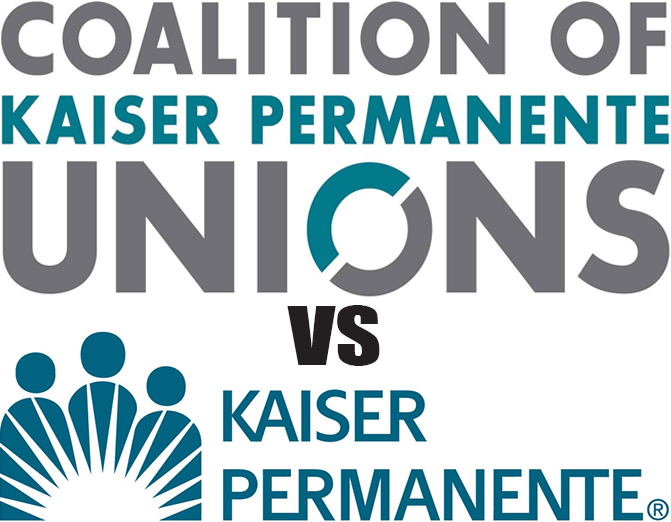Largest healthcare worker strike in U.S. history spans hundreds of Kaiser Permanent hospitals and facilities across the nation

75,000 U.S. healthcare workers of the Coalition of Kaiser Permanente Unions protest claims of unfair labor practices
By Isaac Reese, 617 Media Group
10/4/23 7:00 P.M. UPDATE: “Frontline healthcare workers are awaiting a meaningful response from Kaiser executives regarding some of our key priorities including safe staffing, outsourcing protections for incumbent healthcare workers, and fair wages to reduce turnover. Healthcare workers within the coalition remain ready to meet at any time. Currently, the strike continues, and there are no sessions scheduled at this hour,” said Caroline Lucas, spokesperson, Coalition of Kaiser Permanente Unions.
More than 75,000 Kaiser Permanente workers in multiple states are now on strike to protest unfair labor practices and Kaiser executives’ failure to bargain in good faith over unsafe staffing levels at hundreds of Kaiser hospitals and facilities across the United States.
Over the course of just three hours, the strike at Kaiser facilities expanded from coast to coast, following months of bad faith bargaining activity by Kaiser executives and repeated appeals by frontline healthcare workers for Kaiser executives to make the kinds of investments in staffing that could help stem employee turnover and reduce growing patient wait times.
The strike began in DC and VA at 6AM ET this morning, expanded to CO at 6AM MT, then culminated with tens of thousands of workers striking in CA, OR, and WA at 6AM PT.
In the vast majority of locations, barring an agreement, the strike is expected to last for three days. It is already the largest healthcare worker strike in U.S. history.
Healthcare workers are taking the work action to protest Kaiser executives’ bad faith bargaining, which is getting in the way of finding solutions to solve the Kaiser short-staffing crisis by investing in its workforce.
In recent days, Kaiser executives maintaining aggressive threats of outsourcing became a sticking point in negotiations, especially at a time when the company is failing to retain key employees.
“Kaiser executives are refusing to listen to us and are bargaining in bad faith over the solutions we need to end the Kaiser short-staffing crisis,” said Jessica Cruz, a licensed vocational nurse at Kaiser Los Angeles Medical Center. “I see my patients’ frustrations when I have to rush them and hurry on to my next patient. That’s not the care I want to give. We’re burning ourselves out trying to do the jobs of two or three people, and our patients suffer when they can’t get the care they need due to Kaiser’s short-staffing.”
Strike lines are set up at Kaiser Permanente hospitals and medical office buildings across the country, including California, Colorado, Washington, Oregon, Virginia and Washington, D.C.
Workers on strike include those employed as licensed vocational nurses, emergency department technicians, radiology technicians, ultrasound sonographers, teleservice representatives, respiratory therapists, x-ray technicians, optometrists, certified nursing assistants, dietary services, behavioral health workers, surgical technicians, pharmacists and pharmacy technicians, transporters, home health aides, phlebotomists, medical assistants, dental assistants, call center representatives, and housekeepers, among hundreds of other positions.
BACKGROUND
The Coalition of Kaiser Permanente Unions represents 85,000 Kaiser healthcare workers in seven states and the District of Columbia. In April, the Coalition began its national bargaining process ahead of the September 30th contract expiration. On Sept. 22, Coalition unions representing 75,000 Kaiser healthcare workers gave Kaiser executives 10-day notices for an unfair labor practice strike beginning Oct. 4. The Coalition and Kaiser Permanente last negotiated a contract in 2019, before healthcare workers found themselves on the frontlines of the COVID pandemic that has worsened working conditions and exacerbated a healthcare staffing crisis.
At issue, healthcare workers say, are a series of unfair labor practices related to bargaining in bad faith, along with simmering staff concerns related to unsafe staffing levels that can lead to dangerously long wait times, mistaken diagnosis, and neglect. After years of the COVID pandemic and chronic understaffing, Kaiser healthcare workers are calling on management to provide safe staffing levels.
Workers say that Kaiser is committing unfair labor practices and also that understaffing is boosting Kaiser’s profits but hurting patients. In a recent survey of 33,000 employees, 2/3 of workers said they’d seen care delayed or denied due to short staffing. After three years of the COVID pandemic and chronic understaffing, healthcare workers at Kaiser Permanente are calling on management to provide safe staffing levels.
Kaiser has reported $3 billion in profits in just the first six months of this year. Despite being a non-profit organization – which means it pays no income taxes on its earnings and extremely limited property taxes – Kaiser has reported more than $24 billion in profit over the last five years. Kaiser’s CEO was compensated more than $16 million in 2021, and forty-nine executives at Kaiser are compensated more than $1 million annually. Kaiser Permanente has investments of $113 billion in the US and abroad, including in fossil fuels, casinos, for-profit prisons, alcohol companies, military weapons and more.
The Coalition of Kaiser Permanente Unions unites more than 85,000 healthcare workers at Kaiser Permanente facilities in California, Colorado, Oregon, the District of Columbia, Hawaii, Maryland, Virginia, and Washington
Kaiser issued a statement last month responding to the then-threatened strike.
Allen D. Payton contributed to this report.
the attachments to this post:

Coalition of KP Unions vs Kaiser stacked

























